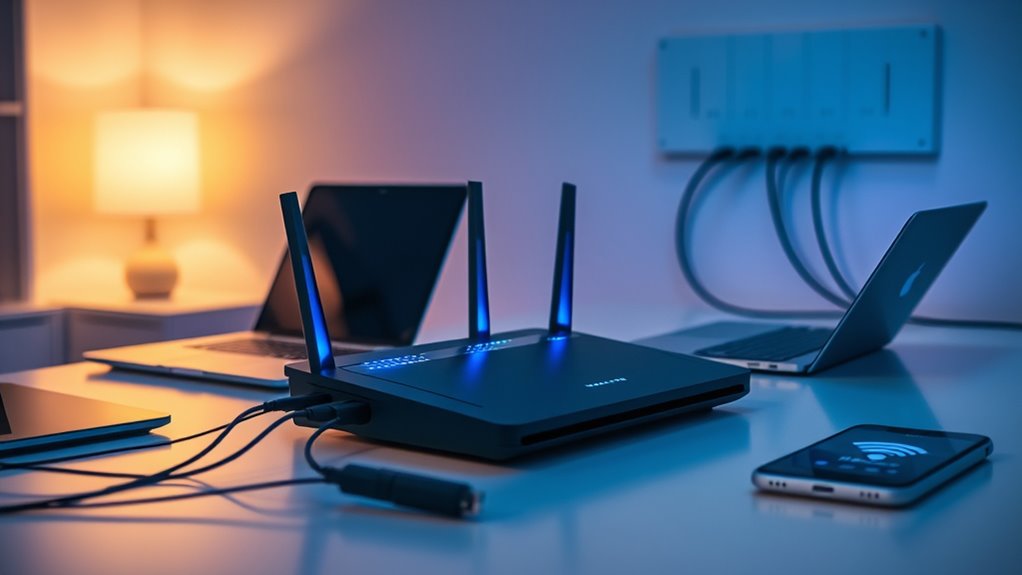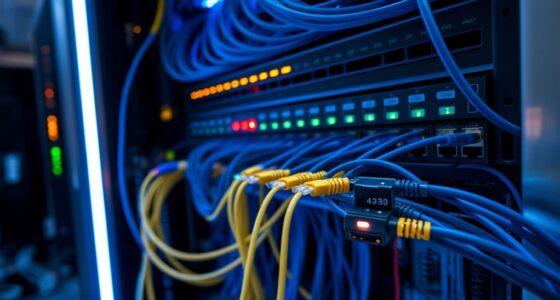To build a reliable home network, start by evaluating your device needs, internet usage, and budget. Choose compatible modems and routers with features like dual-band or Wi-Fi 6 for faster, stable connections. Plan your layout to minimize interference, place equipment centrally, and connect key devices via Ethernet for better speed. Secure your network with strong passwords and encryption. For more tips on optimizing and maintaining your setup, keep exploring these essential steps.
Key Takeaways
- Assess your devices, bandwidth needs, and budget to plan an effective wired and wireless home network layout.
- Select compatible modems, routers with advanced features like Wi-Fi 6, and expand connections with Ethernet switches.
- Optimize router placement, update firmware, and use signal extenders or mesh systems to improve coverage and eliminate dead zones.
- Prioritize critical devices, manage traffic, and regularly update equipment to maintain reliable network performance.
- Implement layered security, monitor network health, and upgrade hardware proactively to ensure ongoing security and efficiency.
Assessing Your Home Network Needs
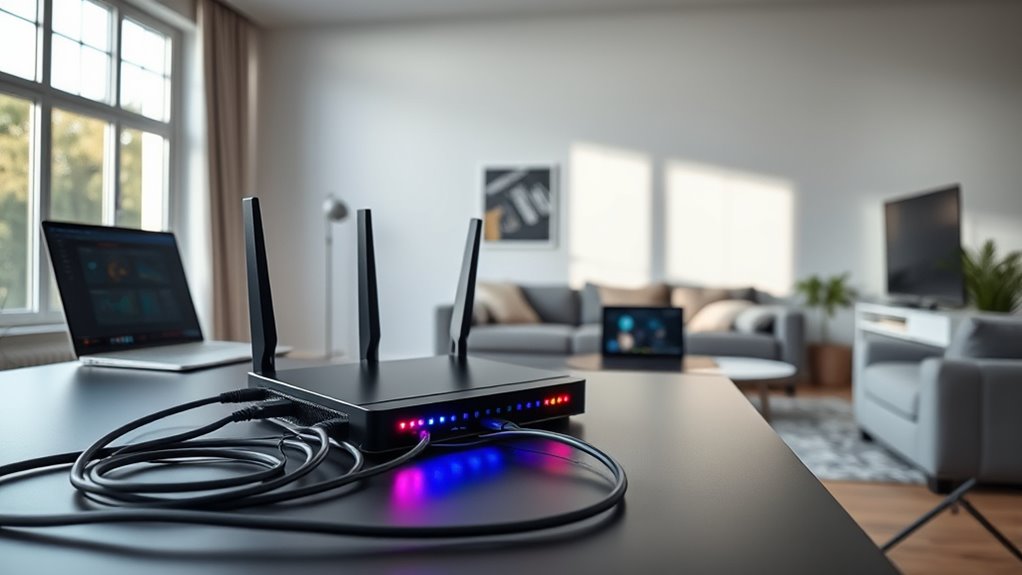
Before upgrading or setting up your home network, you need to understand what you actually require from it. Start by evaluating your device compatibility—identify all the devices you’ll connect, from smartphones and laptops to smart home gadgets. Consider how many devices will be active simultaneously to determine your bandwidth needs. Your budget considerations also play a key role; decide how much you’re willing to spend on equipment and plan accordingly. If you only need basic internet access, a simple setup might suffice. But if you stream high-definition videos or game online, you’ll need more robust hardware. Knowing your specific requirements helps you avoid overspending on unnecessary features or underestimating what you need for a smooth, reliable connection. Additionally, understanding your networking needs ensures you select the right equipment and configuration to optimize performance. Being aware of privacy policies and data management practices can also influence your choice of networking hardware and providers. Moreover, recognizing the importance of contrast ratio in visual clarity can help you select networking equipment that minimizes interference and maximizes signal quality. Incorporating quality of service settings can further enhance your network performance by prioritizing critical devices and applications.
Choosing the Right Modem and Router
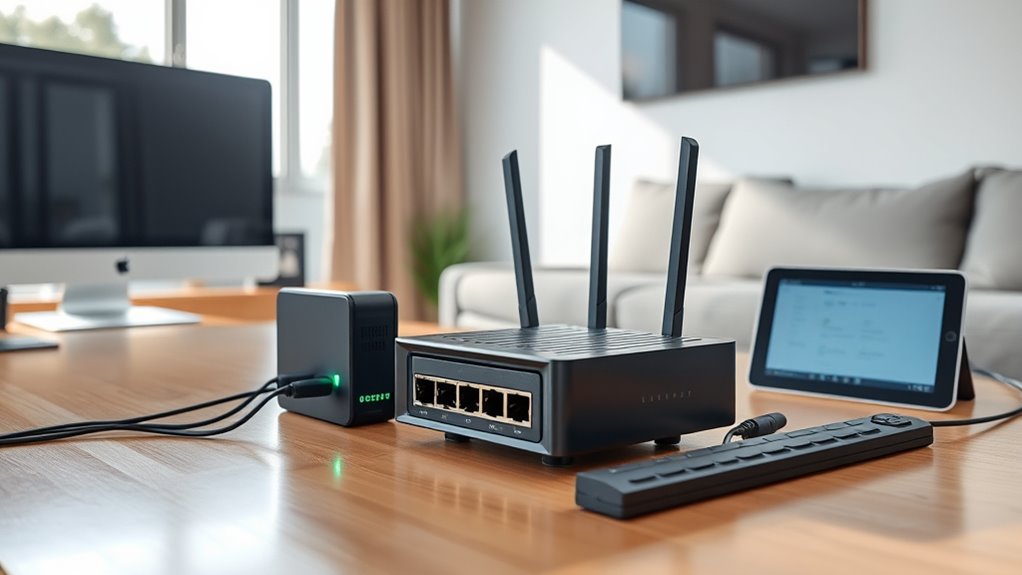
Selecting the right modem and router is vital for building a reliable home network, as these devices directly impact your connection speed and stability. When choosing a modem, consider modem types such as cable, DSL, or fiber, matching your internet service provider’s requirements. For routers, focus on features like dual-band or tri-band capabilities, Wi-Fi 6 support, and coverage range to guarantee peak performance. Your router’s features determine how well your network handles multiple devices and high-bandwidth activities, like streaming or gaming. Compatibility between your modem and router is fundamental, so check that they work seamlessly together. Investing in quality modem types and routers with advanced features will provide a faster, more secure, and more reliable home network experience. Additionally, selecting advanced networking features can enhance overall connectivity and future-proof your setup.
Planning Your Network Layout
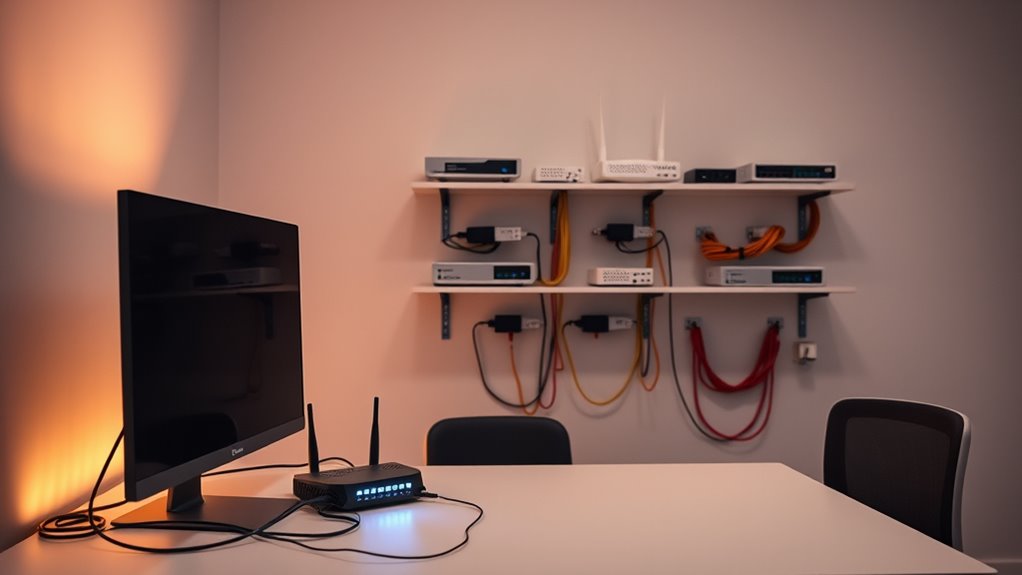
To guarantee your home network runs smoothly, planning your layout carefully is essential. Consider using a mesh network to ensure strong, seamless coverage throughout your home, eliminating dead zones. Mesh systems are scalable, allowing you to add nodes as needed for better performance. Think about network segmentation to improve security and manage traffic effectively. By dividing your network into separate segments—for example, one for smart devices and another for personal computers—you reduce potential vulnerabilities and optimize bandwidth. Place your router centrally to maximize coverage, and position access points or mesh nodes strategically to extend reach. Planning your layout upfront helps prevent future connectivity issues, ensures reliable performance, and creates a secure environment for all your devices.
Setting Up Wired Connections

While wireless connections are convenient, setting up wired connections provides a reliable backbone for your home network. Begin by running Ethernet cabling from your router to key areas where devices like desktops, gaming consoles, or smart TVs will be located. Use high-quality Ethernet cables, such as Cat6 or Cat7, for peak performance. To connect multiple wired devices, incorporate network switches into your setup. These switches expand the number of Ethernet ports available, making it easier to connect several devices simultaneously. Mount the switches in a central location for efficient cable management and minimal signal loss. Make sure all cables are securely plugged in, and test each connection for stability. A wired setup with Ethernet cabling and network switches offers the speed and reliability essential for smooth internet use.
Configuring Wireless Networks
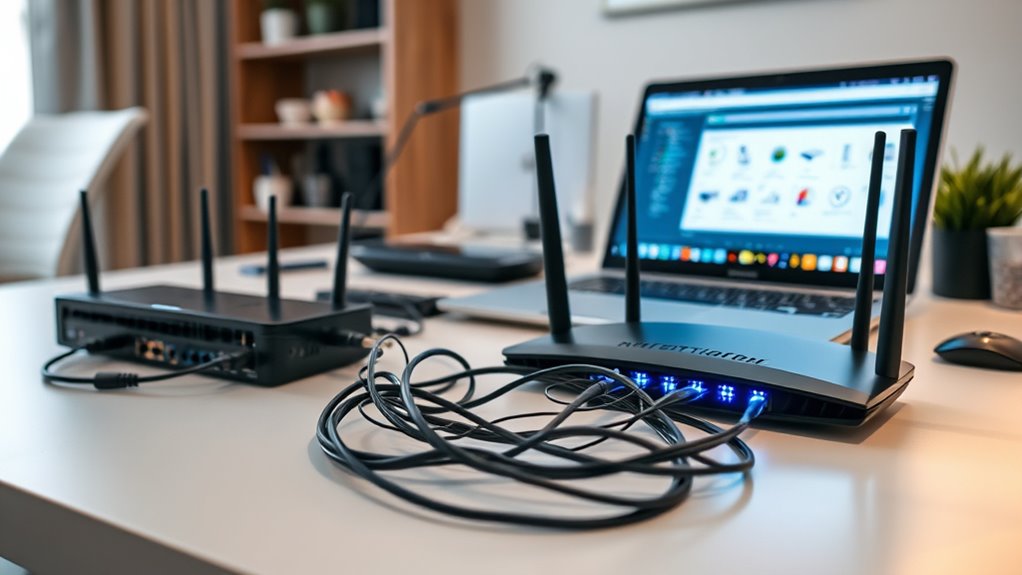
Setting up your wireless network involves choosing the right router and configuring it properly to guarantee a strong, secure signal throughout your home. Start by selecting a router that supports modern Wi-Fi standards like 802.11ac or 802.11ax for faster speeds and better coverage. Access the router’s settings to enable network encryption, such as WPA3, to keep your data safe. Use a strong, unique password to prevent unauthorized access. Adjust the channel settings to minimize interference. Here’s a quick overview:
| Wi-Fi Standards | Network Encryption | Tips |
|---|---|---|
| 802.11ac/ax | WPA3 | Use strong passwords |
| 802.11n | WPA2 | Change default SSID |
| 802.11g | WPA | Keep firmware updated |
Configuring these settings helps guarantee a secure, high-performance wireless network. Additionally, choosing a router with advanced features can further enhance your network’s reliability and security. Understanding wireless security protocols is essential to protect your network from unauthorized access and potential threats.
Enhancing Security for Your Home Network

Securing your home network is essential to protect your personal data and prevent unauthorized access. Start by configuring your firewall settings to block unwanted traffic and monitor network activity. Proper firewall configurations act as a barrier, filtering incoming and outgoing data to keep threats at bay. Additionally, focus on password management; use strong, unique passwords for your Wi-Fi and router admin accounts. Regularly update these passwords and avoid reuse across devices. Enable network encryption like WPA3 to safeguard your wireless connection. Keep your firmware up to date, as updates often include security patches. These steps create multiple layers of defense, making it considerably harder for intruders to compromise your network. Practicing self-awareness about your network security habits can help identify vulnerabilities before they are exploited. Building a security mindset helps maintain vigilance and adapt to evolving threats, ensuring your home network remains safe and private.
Troubleshooting Common Connectivity Issues
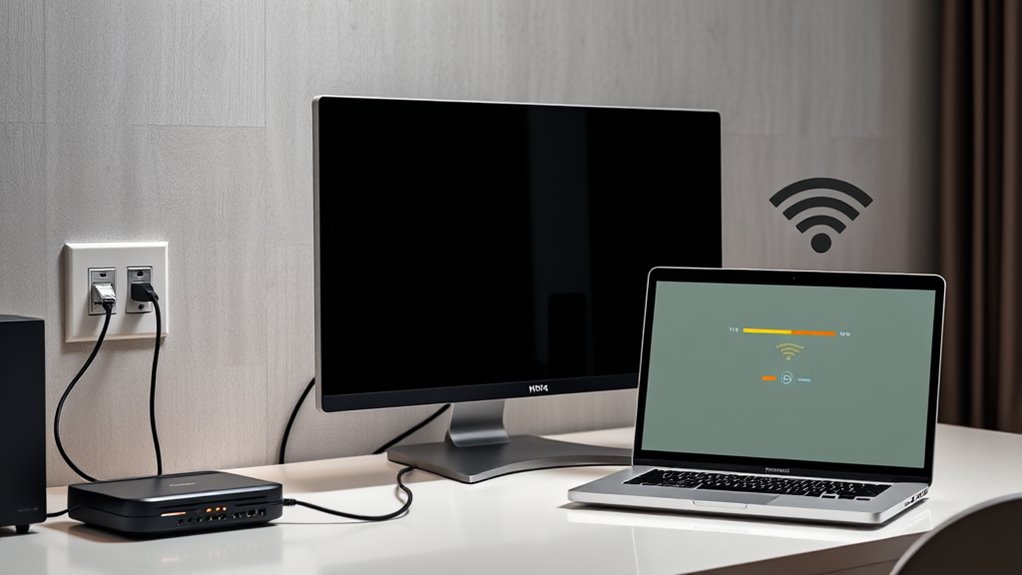
When your Wi-Fi connection drops or slows down, signal interference might be the culprit. Moving your router to a central, open spot can reduce interference and improve coverage. Proper router placement and minimizing obstacles are key steps to resolving common connectivity issues. Utilizing data-driven strategies can help identify specific interference sources and optimize your network setup. Additionally, understanding wireless frequency bands can assist in selecting the best channels to minimize congestion and improve performance. Recognizing the influence of technology on artistic expression can also inspire creative adjustments to your network environment, fostering innovation and personalized solutions. Incorporating well-being tips such as reducing physical obstacles and selecting optimal locations can significantly enhance Wi-Fi reliability and user experience.
Signal Interference Solutions
Have you ever experienced dropped connections or slow internet speeds in certain areas of your home? Interference sources like cordless phones, microwaves, and thick walls can disrupt your Wi-Fi signal, causing frustration. To fix this, consider these solutions:
- Identify interference sources and move devices away from your router.
- Use signal boosting devices like Wi-Fi extenders or mesh systems to strengthen weak signals.
- Switch to less congested Wi-Fi channels to reduce interference from neighboring networks.
- Opt for dual-band routers that allow you to separate devices onto different frequencies, minimizing signal clashes.
- Being aware of potential signal interference sources can help you better troubleshoot and improve your network stability. Additionally, understanding AI security vulnerabilities can aid in safeguarding your connected devices from cyber threats.
- Recognizing home networking best practices, such as proper placement of your router, can significantly enhance overall connectivity and reliability.
Router Placement Tips
Proper router placement can make a significant difference in resolving connectivity issues caused by interference or weak signals. To optimize performance, focus on router orientation; position the device upright to maximize signal coverage. Keep the router away from metal objects, microwaves, and cordless phones, which can cause interference. Elevate the router to avoid dead zones and ensure signals reach all areas of your home. Avoid placing it in cabinets or behind furniture that block Wi-Fi signals. To further mitigate dead zones, consider using a Wi-Fi extender or mesh system in larger spaces. Regularly test signal strength in different rooms and adjust the router’s position accordingly. Proper placement and orientation are key to maintaining a strong, reliable connection throughout your home network. Additionally, understanding wireless standards can help you select the best equipment for your needs. Incorporating knowledge about raw food safety and proper sourcing can also be useful when considering network security and device hygiene, ensuring a safer digital environment. Staying informed about network security protocols and implementing them can further protect your devices and data. Ensuring your devices and network hardware are kept up to date can also improve security and performance.
Optimizing Network Performance
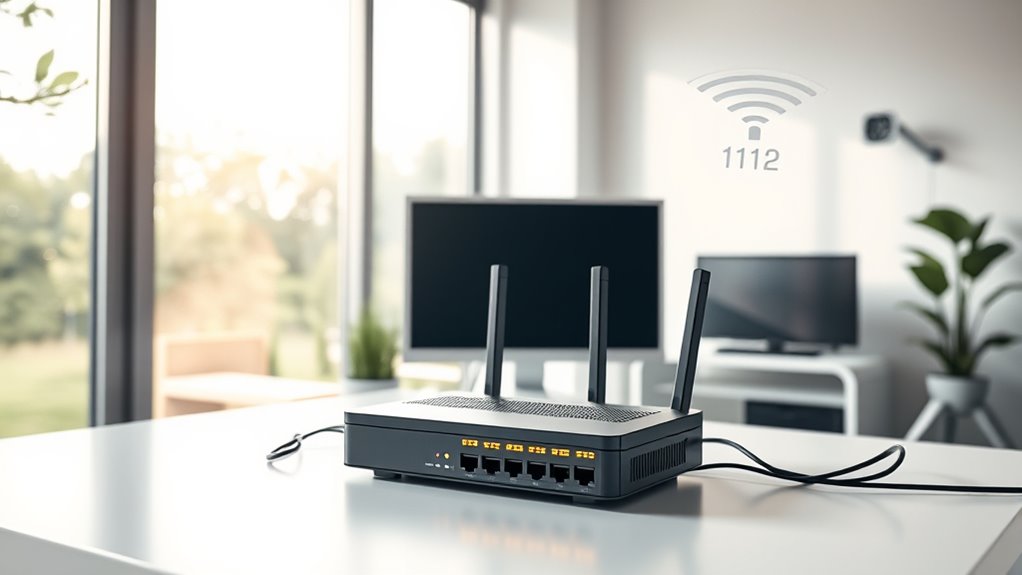
To guarantee your home network runs smoothly and efficiently, optimizing network performance is essential. Focus on managing bandwidth allocation and device prioritization to reduce lag and buffering. Here are four key steps to boost your setup:
- Identify high-traffic devices and allocate bandwidth accordingly to ensure smooth streaming and gaming.
- Prioritize critical devices like work computers or smart home hubs to keep them running seamlessly.
- Limit background applications that consume excessive data when not needed, which can help prevent nutrient deficiencies that slow down network performance.
- Update firmware regularly to fix bugs and improve overall network stability.
Additionally, considering the use of hydrocolloid technology patches can help keep your network environment clean and free of impurities that may slow down performance.
Introducing proper cable management and using high-quality cables can further enhance your network’s reliability and speed.
Maintaining and Upgrading Your Network Over Time
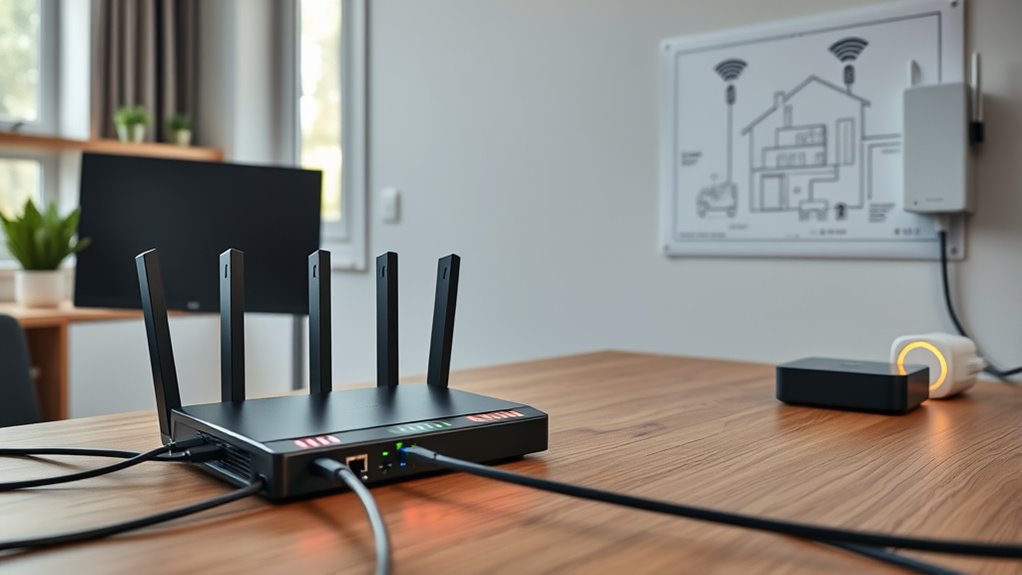
Regularly maintaining and upgrading your home network guarantees it remains secure, reliable, and capable of handling new devices and demands. Start by performing firmware updates on your router and connected devices; these updates fix vulnerabilities and improve performance. Consistent network monitoring helps identify issues early, such as slow speeds or unauthorized access, so you can address them promptly. Keep an eye on your network’s traffic and device connections to ensure everything functions smoothly. Upgrading equipment when necessary, like replacing outdated routers or expanding your Wi-Fi coverage, ensures your network stays current. By staying proactive with firmware updates and network monitoring, you maintain a secure, efficient home network capable of supporting your evolving digital needs.
Frequently Asked Questions
How Do I Prioritize Bandwidth for Specific Devices or Applications?
To prioritize bandwidth for specific devices or applications, you should set up bandwidth management through your router’s Quality of Service (QoS) settings. Access your router’s admin panel, locate the QoS section, and assign higher priority to your critical devices or apps. This guarantees that essential activities get the bandwidth they require, preventing lag and buffering, especially during heavy network usage. Regularly monitor and adjust these settings for peak performance.
What Are the Best Practices for Extending Wi-Fi Coverage?
A chain is only as strong as its weakest link, so start by placing your Wi-Fi extender in a central spot, away from obstructions. Use reliable networking accessories like high-quality extenders or mesh systems, and guarantee proper cable management to prevent clutter and interference. Regularly update firmware and optimize placement to maximize coverage. This approach helps you extend Wi-Fi coverage effectively, keeping your network fast and reliable everywhere.
How Can I Set up a Guest Network Securely?
To set up a secure guest network, enable guest isolation on your router to prevent guests from accessing your main devices. Use network segmentation to separate your main and guest networks, enhancing security. Make sure to set a strong, unique password for the guest Wi-Fi and disable device-to-device communication. Regularly update your router firmware and monitor network access to keep your network safe and private.
What Are Common Signs of a Compromised Home Network?
Imagine your home network as a locked door; if you notice unfamiliar devices connected or slow internet, it’s like someone’s been sneaking in. Common signs of a compromised network include unexpected device activity, frequent disconnects, or increased data usage. These point to a possible network intrusion or unauthorized access. Stay vigilant, change your passwords regularly, and monitor your network traffic to protect your digital space from intruders.
How Often Should I Update Firmware on My Networking Devices?
You should update your firmware regularly, ideally once a month, to guarantee device compatibility and security. Keeping firmware current helps prevent firmware risks like vulnerabilities that hackers could exploit. Check your device manufacturer’s website or admin panel for updates, and install them promptly. Regular updates not only improve performance but also protect your network from potential threats by fixing security flaws and enhancing device functionality.
Conclusion
Building a home network is like crafting a finely tuned orchestra—you need the right instruments and harmony to perform flawlessly. By evaluating your needs, choosing quality equipment, and securing your setup, you create a reliable foundation for all your digital activities. Keep your network updated and troubleshoot wisely, and you’ll enjoy seamless connectivity that feels as effortless as a gentle breeze. With patience and care, your home network becomes a well-oiled machine, ready to serve your digital life.
